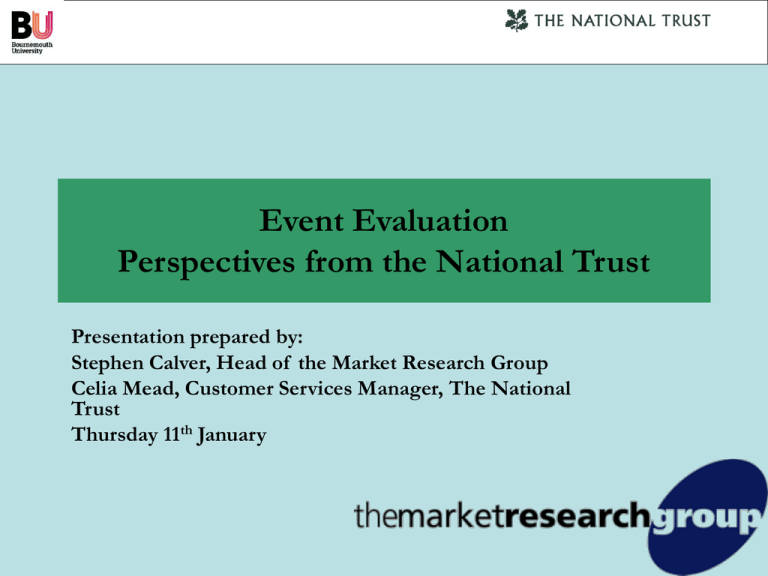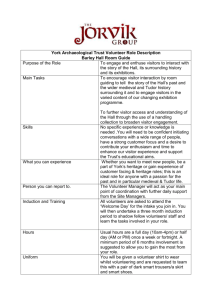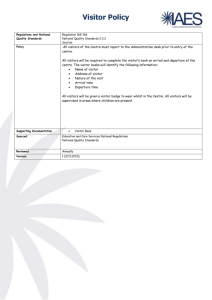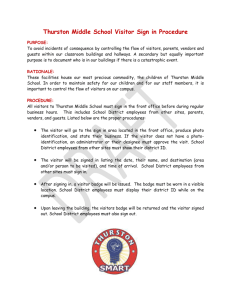Steve Calver - The Market Research Group( 4mb)
advertisement

Event Evaluation Perspectives from the National Trust Presentation prepared by: Stephen Calver, Head of the Market Research Group Celia Mead, Customer Services Manager, The National Trust Thursday 11th January Size and scope • The National Trust offers over 10,000 events per annum in England, Northern Ireland and Wales • These generate over £5mn of direct revenue • The National Trust is a charity that relies upon its commercial efficiency to achieve its conservation aims. Why evaluate? • To measure the extent of engagement and understanding • Have visitors enjoyed themselves? • How can operational efficiency be improved? • How can marketing and planning be better targeted? Classification of events • ‘Value added’ events • Interpretative walks and tours • Income generating events • Temporary exhibitions • Large scale public events – private hire The dataset The data for evaluation is obtained from three primary sources • National Heritage Survey • National Visitor Survey • Events Survey Target Groups • ABC1/C2 Socio economic groups (Market Research Society Algorithm) • MOSAIC Geo-demographic analysis from postcodes • Members/ Non members of the National Trust • Young families – children 0-11yrs • Older families – children 12-15 • Independents • Older independents National Heritage Visits Survey • Conducted annually, national coverage to evaluate role of heritage visits in the national leisure ‘portfolio’ • Questions derived from small group, qualitative research • Quota sampling, face to face interviewing of sample population • Data collected since 1998 National Visitor Survey • All large properties (by visitor number) nationwide participate plus a sample of smaller properties and ‘open site’ properties. • Questions derived from qualitative research. • Self completion questionnaire, control groups of face to face interviews, depth interviews • Data collected since 2000 nationally; since 1992 for some regions of the National Trust • Database of over 250,000 cases Events Survey • Introduced in 2006 in the Wessex Region • Questions derived from qualitative research • Quota sampling, face to face interviewing at key properties The Heritage Visits Survey Battle enactments at Corfe Castle • 2006 survey includes 5 questions specifically investigating attitudes and behaviour regarding events at historic properties. • The following slides give details from two of them Egyptian Art exhibition at Kingston Lacy ‘Would you be interested in any of the following activities at National Trust properties’? % 16 16 15 14 13 12 11 11 10 Children's activities Children's educational tours Interactive displays Presentations about gardening Presentations about family Sports events Concerts Exhibitions Visiting the shop 9 Presentations about art 7 Specialist tours 6 Guided tour of house 5 5 Guided tour of gardens Guided archeological tours Guided tour of country site 2 Heritage visits survey 2006 Base 827 ‘Have you attended any of the following types of event at an historic property during the past 12 months?’ % Includes 'Once', 'Twice', 'More than Twice' Special day' 30 Musical event 28 Theatrical 16 Exhibition 16 Tour of property 12 Heritage visits survey Base 827 Lecture/presentation 9 ‘Special Days’ e.g Apple Fairs, Book Fairs The National Trust Visitor Survey What was the purpose of your visit today? Please tick one box only Pay for entry, Non event specific % To see the house 26 A nice day out 15 To see the gardens 14 To go for a walk 7 Interest in history 7 To be with family & friends 7 Beautiful places 4 Things for children to do 3 To show family/friends 3 Tearoom/restaurant 3 Enjoy the peace & quiet 2 To relax 2 Special event 2 Shop 1 Interest in art 1 Exhibition 1 The top six motivators include a mix of pragmatic factors (house, garden, walk) and experiential (a nice day out). 2006 National Visitor Survey Base 37520 There is a strong link between purpose of visit and length of stay at the property (and therefore spend). The average proportion of the visitor population staying longer than 3hrs at National Trust properties is 31% There are 5 motivational categories that stay longer than average To Show Family and Friends - 46% more than 3 hrs A Nice Day Out - 45% more than 3 hrs To attend an event - 40% more than 3hrs Interest in Art - 36% more than 3hrs Things for Children to do - 34% more than 3hrs 2006 National Visitor Survey Base 37520 Do event visitors have a different planning schedule to other visitors? % Event visitors 32 35 All 25 27 22 20 20 17 Today Yesterday 2006 National Visitor Survey Base 37520 This week Some time ago Which media prompted the visit? % NT Handbook 11 NT Leaflets 11 NT Regional new s letters 5 1 31 Advert - News/Mag Base 37520 3 10 1 Events visitors 8 All NT Internet Website 2006 National Visitor Survey 9 ArticleNews/Mag/Radio/TV 5 2 Television and film promote specific properties and provide themes for events Variation in points of origin? % 15 Under 5 miles 11 75 Home 57 30 5-14 miles Friends/relatives 25 5 8 22 22 15-24 miles 16 Holiday accommodation Other 32 4 3 22 25-49 miles 50-74 miles 24 6 10 2006 National Visitor Survey Base 37520 75+ miles 6 8 Events Visitors All Events Research 2006 Falconry displays and other rural ‘crafts’ are popular with mixed groups Afternoon performances are popular with families ‘Which of the following have provided you with the information to attend an event in the past 12 months’? % 76 Friends & Relatives 55 Adverts 41 Articles 39 The Internet 38 TICs Events programmeorganisation 19 Events programmeproperty 11 Newsletter from organisation Your contact with property 10 5 2006 Events survey Base 476 How important was this event in your decision to visit today? (Property Open) % Very important 15 Important 12 Neutral 13 Not important Not at all important Did not know about event before arriving 5 7 48 2006 Events survey Base 476 How important were the following for your visit today? (Property open) Very Important% Entertaining children 52 Occasion for friends to get together 51 Specific Interest in event 38 *‘Entertaining children’ (only respondents with children) Part of property visit Educational Outing In the area 2006 Events survey Base 476 22 7 13 Evaluation of concerts, plays and other ticket events • Fifteen categories have been identified which represent critical measures of evaluation by the visitor. • There is a strong positive relationship between five of these categories and attendance at cultural events generally. • There is a strong positive relationship between five of these categories and motivation to visit 2006 Events survey Base 476 ‘Concerts, plays and other events requiring a ticket. How would you rate this event with regard to the following’ Timely promotion of event Very good _ _ _ Very Poor Example – Evaluation related to attendance at cultural events and motivation to attend event Attendance at cultural events – 4 times a year Entertaining the children Timely promotion of the event Access and parking Ease of booking Location of event at property Ease of obtaining further information Seating arrangements/ space allocation Access and parking Guides programmes and other information Ease of obtaining further information Seating arrangement Evaluation of Exhibitions, fairs, enactments, walks and interactive events • Fourteen categories have been identified which represent critical measures of evaluation by the visitor. • There is a strong positive relationship between four of these categories and attendance at cultural events generally. • There is a strong positive relationship between four of these categories and motivation to visit Attendance at cultural events – 4 times a year Available information before the visit Information and explanation from staff Opportunities for interaction Access and parking MOSAIC Groups • MOSAIC is a commercial segmentation package produced by Experian; it classifies all consumers in the United Kingdom into 11 groups subcategorised into 61 types. • MOSAIC provides a useful means of understanding consumer attitudes and predisposition in order to direct marketing strategy and evaluation of marketing. MOSAIC group analysis- Large ticket event/ Wessex % 23 Symbols of success 11 10 Happy Families 18 20 Suburban Comfort 7 7 Ties of the Community 2 Urban Intelligence Welfare Borderline Municipal Dependency Blue Collar Enterprise Twilight subsistence UK POPULATION Symbols of success 10% Happy Families 11% Suburban Comfort 15% Ties of the Community 16% Urban Intelligence 7% Welfare Borderline 6% Municipal Dependency 7% Blue Collar Enterprise 11% Twilight Subsistence 4% Grey Perspectives 8% Rural Isolation 5% 4 0 0 0 0 Fete Wessex 2 3 1 1 14 12 Grey Perspectives Rural isolation 34 9 22 MOSAIC group analysis –Value added events/Wessex % 42 Sym bols of success 11 10 Happy Fam ilies Suburban Com fort 0 0 Municipal Dependency 00 1 Blue Collar Enterprise Welfare Borderline Rural isolation 20 UK POPULATION 3 4 Urban Intelligence Grey Perspectives 17 7 7 Ties of the Com m unity Tw ilight subsistence 34 1 1 Value added Wessex 3 8 89 12 Symbols of success 10% Happy Families 11% Suburban Comfort 15% Ties of the Community 16% Urban Intelligence 7% Welfare Borderline 6% Municipal Dependency 7% Blue Collar Enterprise 11% Twilight Subsistence 4% Grey Perspectives 8% Rural Isolation 5% GIS – Stourhead Large event GIS – Stourhead Small events www.themarketresearchgroup.com







